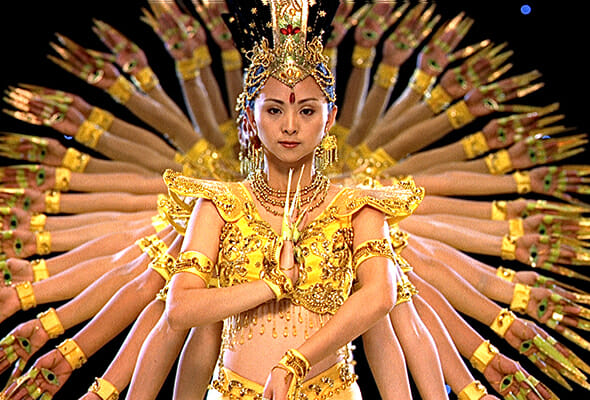
The cinematic dream team of director and cinematographer Ron Fricke and producer Mark Magidson placed the bar high when they set out to make Samsara. A visual montage of portraits and landscapes filmed for over five years in 25 countries, their stage set is literally the world. Their main character is the host of images put onscreen—a slightly more dynamic version of photography—and, being a nonverbal film, the only script is the musical score. Oh, and the plotline? Nothing less than that into which the film’s title translates (from Sanskrit)—“the ever-turning wheel of life.”
With premises that are more conceptual than they are tangible building blocks for a cohesive film, the project could have easily turned into a prolonged National Geographic slideshow—beautiful to look at but with no personal, meaningful connection to its audience. And unlike Fricke and Magidson’s previous two efforts in this vein, Chronos (1985) and Baraka (1992), viewers now have the ability to travel anywhere while sitting in bed and clicking links on YouTube. Are we really going to pay for a visual dose of spirituality? (And didn’t we already see The Tree of Life?)
With Samsara, the answer should be, “Yes.” On the big screen, Fricke and Magidson’s 99-minute tour de force is pure visual and mental intoxication. Weaving together the mystery and power of the natural world with the doings, makings and feelings of humans, past and present, Samsara achieves its makers’ goal of displaying the interconnectedness of life (opera-backed, prolonged cosmos scenes à la Terrence Malick not included).
It’s hard to tire of the film’s visual perfection. Shot entirely on 70mm film but edited digitally, the level of detail is the highest it can possibly be. This widescreen, classic film stock is hardly ever used anymore—especially when that involves schlepping it around the planet—but Fricke and Magidson refused to settle for an easier but less nuanced format. Every location was researched extensively to ensure that their footage would be somehow unique and previously unseen, and most importantly, rather than hiring a crew of editors to deal with the massive amount of footage, Fricke and Magidson meticulously pieced together the entire film themselves. The expertly aligned score by Michael Stearns, which reflects every mood and visual turn of phrase, was composed after the film was complete.
This five-year personal investment pays off in moments of pinpointed cleverness that continually reward close attention. In one instance, a scalp tattoo reading “methodical” segues into a sequence of mass-producing factory shots. Soon after, the factory sequence begins to spiral into a progression of clips from meat processing plants, then a wholesale warehouse store, then Burger King, then a stomach being measured in a plastic surgery office. Disparate images become linked so seamlessly that their relationship seems common sense—and all without a single word being uttered.
In interviews about the film, Fricke has said that this is the point exactly—to not say anything. As soon as a sequence begins to feel like it has a commenting agenda, it immediately cuts to something else. Just when you think a cycle of images is beginning to explain a global phenomenon like war, the sex market or America’s dietary problems (as in the case above), a stunning time-lapse sequence of light painting patterns on sand dunes or a portrait of a geisha with a single tear sliding down her cheek halts the chain of connections, and all you’re left with is marvel.
Fricke, who practices meditation himself, calls this sort of viewing experience a “guided meditation.” Like playing connect-the-dots with stars, the film jumps from one far-out and remote image to the next, showing how they all connect into a bigger global picture. Watching becomes absorbing, and you find yourself asking unsolicited questions that pop out of nowhere. Which is scarier: a normal-looking businessman suddenly transforming into some sort of crazed Hulk-meets-Joker alter ego and covering himself with green clay, or the manmade islands off the coast of Dubai? What does it even mean to be an actor on a stage? Aren’t we all?
Fricke and Magidson are a literal dream team—their film flows in a separate-but-connected dreamlike state, but also because they have created a cinematic work of art that is unrivaled in its genre and likely will remain so for a long time (or at least until their next film). The theme and concept of rebirth will surely not fascinate everyone, but it will take a lot of resistance not to at least be swept away by the imagery for an hour and a half. By the time the credits roll, the film has lived up to its name and come full circle, leaving the viewer to ponder what it means to be a single human in the grand scheme of things—or, even, enlightened.
Director: Ron Fricke & Mark Magidson
Writer: n/a
Starring: n/a
Release Date: Aug. 24, 2012